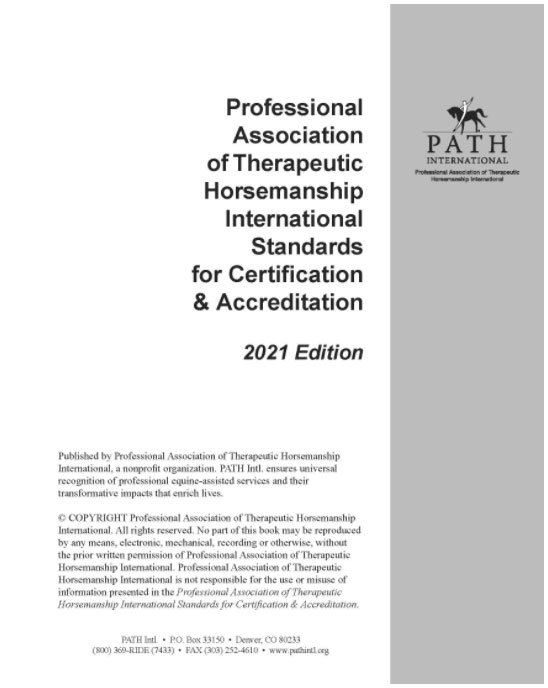PATH Intl. Standards for Certification and Accreditation details voluntary standards for equine-assisted services (EAS), precautions and contraindications for services, a glossary of industry terms and sample forms.
Click here for a summary >
Standards Feedback
PATH Intl. welcomes comments and feedback on its current standards, which can be emailed to the PATH Intl. office at or by using the Membership Standards Feedback form, addressed to the attention of PATH Intl. Standards Committee, PATH Intl., PO Box 33150, Denver, CO 80233. The comments and feedback may also be directed to another committee for review when additional expertise is required. Please note that the submitter’s contact information is required, as the reviewing committee may need additional information and feedback.
About PATH Intl. Standards
History
From the organization’s inception in 1969, members have focused on the establishment of industry guidelines for the practice and teaching of equine-assisted services to ensure that our centers and instructors maintain the safest, most ethical and most effective programs possible for the thousands of people participating in those services. The commitment of our founders and early leaders to quality center accreditation and instructor certification has become a cornerstone of the organization. PATH Intl.’s goals and objectives continue to emphasize the importance of these programs and our staff, volunteers and Board are always working to ensure our standards remain up-to-date.
Standards Development Process
The standards development policies and procedures govern the development of standards, including consensus for approval, appeal, and revision. These policies and procedures allow for due process and building consensus for the approval of new field test standards, revisions that change the intent of current standards and the appeal of existing standards.
Disclaimer
The purpose of these standards is to educate program directors, program personnel and staff, and the public regarding best practices and procedures followed within the therapeutic riding industry. These standards are voluntary but provide the basis for PATH Intl. instructor certification and center accreditation. It should be understood that each standard or each part of every standard may not be applicable to all therapeutic riding programs. Further, these standards do not include every practice or procedure that might be desired or implemented by a program since the services, conditions, facilities and objectives of all programs are not identical. PATH Intl. does not suggest or infer that those who do not follow all of these standards or recommendations engage in unsafe practices.
The PATH Intl. Premier Accredited Center status may be achieved only by those member centers that satisfy eligibility requirements and voluntarily implement PATH Intl. Center and Program standards. Programs outside of these definitions or criteria are not subject to our standards and are not considered for accreditation.
While PATH Intl. requires all accredited centers to participate in regular visits and membership renewals, PATH Intl. does not claim to verify complete and continuous adherence to all standards at all centers. Nor does PATH Intl. warrant, guarantee or insure that compliance with these standards will prevent any or all injury, loss or litigation that may be caused by or associated with any person’s use of facilities, equipment, horses, or other items or activities that are included in the content of these standards, nor does PATH Intl. assume any responsibility or liability for any such injury or loss.
Further, PATH Intl. hereby expressly disclaims any responsibility, liability or duty to member programs, directors, program personnel and staff, clientsand participants or their families for any such liability arising out of injury or loss to any person by the failure of such member programs, directors or program personnel and staff to adhere to these standards or guidelines.

